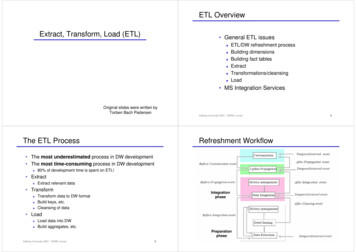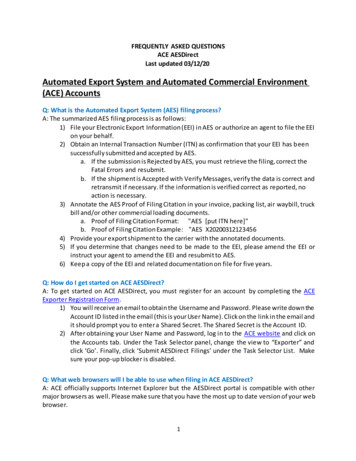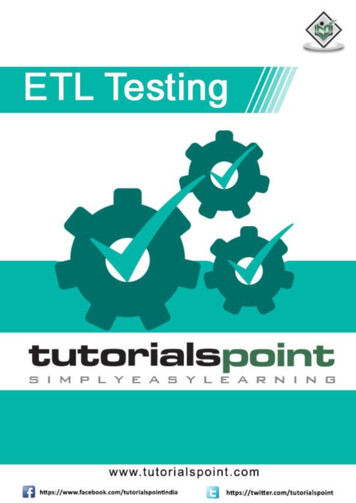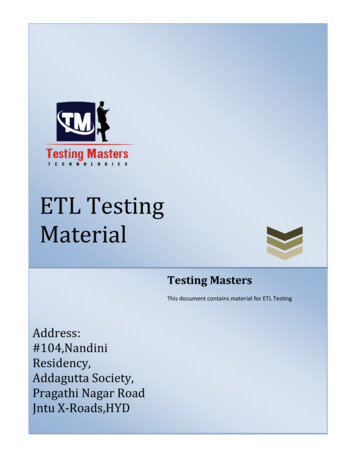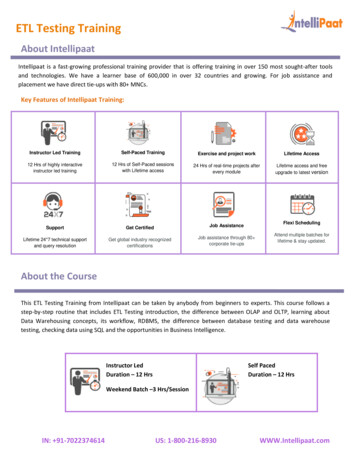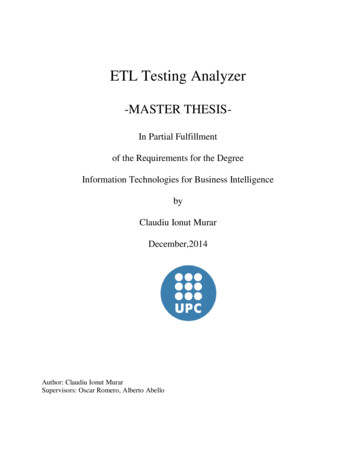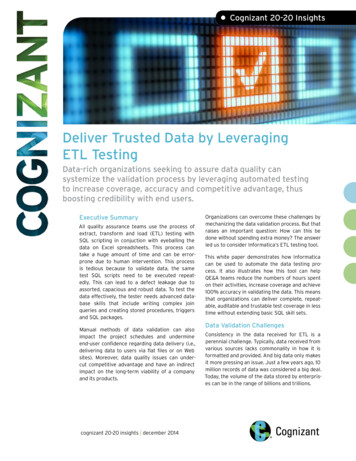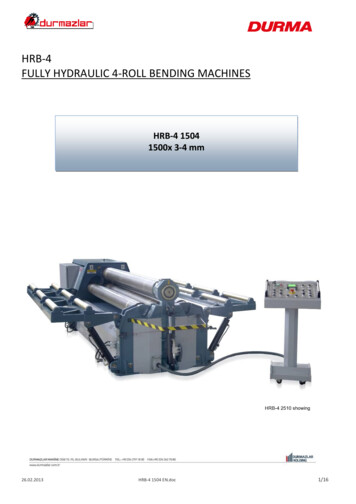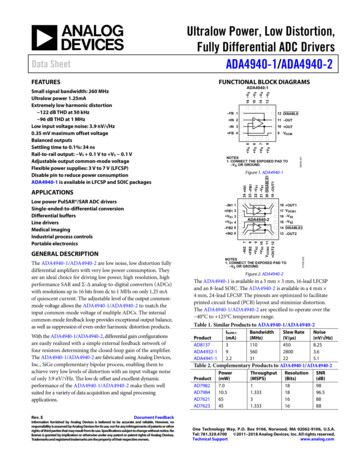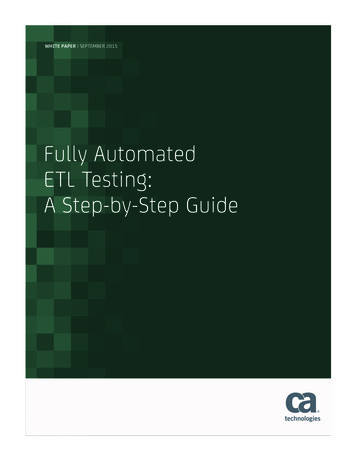
Transcription
WHITE PAPER SEPTEMBER 2015Fully AutomatedETL Testing:A Step-by-Step Guide
2 WHITE PAPER: FULLY AUTOMATED ETL TESTINGca.comSection 1The Critical Role of ETL for the Modern OrganizationSince its eruption into the world of data warehousing and business intelligence, Extract, Transform, Load (ETL)has become a ubiquitous process in the software world. As its name suggests, an ETL routine consists of threedistinct steps, which often take place in parallel: data is extracted from one or more data sources; it is convertedinto the required state; it is loaded into the desired target, usually a data warehouse, mart, or database. A developedETL routine will also often include error-handling, logging infrastructure and the routine environment.1Until now, ETL has been used primarily to prepare often large and disparate data for analytics and businessintelligence. However, its use is broadening beyond simply moving data, with migrating data for new systems anincreasingly common application, as well as handling data integrations, sorts, and joins.2ETL is therefore a critical feature of the modern, fast-moving development lifecycle, where multiple releases andversions are developed in parallel at any given time. Organizations must be able to constantly enhance, integrateand innovate their software, with data available to testers and developers in the right state for each iterationand release. The data will be drawn from the same sources, but must be transformed to match each individualteam’s specific requirements. This is especially true if an organization is striving to be “Agile”, or to successfullyimplement Continuous Delivery.A good example of the critical role of ETL in Continuous Delivery was found at a large multi-national bank, whichCA Technologies worked with. The bank was in the process of making an acquisition, and had to migrate theacquired banks customers, products and financials into their existing infrastructure. This meant that 80 insertionfiles had to be retrieved, converted, and validated, before being uploaded to the banks’ back-end systems. Suchdata further had to be available across 47 projects in parallel, with the referential integrity of data maintained.3In this instance, ETL was critical to enabling the parallelism required for successful Continuous Delivery.However, in spite of the increased use and importance of ETL, ETL testing reflects the state of testing in general,in that it is too slow and too manual, and yet allows an unacceptably high amount of defects through to production.This paper will set out the challenges encountered in a typical approach to ETL testing is typically approached,exploring the challenges encountered. An alternative, broadly model-based approach will then be set out,considering how it might make ETL testing far more efficient, effective, and systematic.Section 2The Typical Approach to ETL Testing and the Common ChallengesEncounteredWhen validating ETL transformation rules, testers typically create a shadow code set, use it to transform data,and then compare the actual results to the expected results. Usually, ETL scripts or SQL is manually copied to thesource data and run, with the results recorded. The same script is then copied to the target data, with the resultsrecorded. The two sets of results (actual and expected) are then compared, to validate that the data has beencorrectly transformed.
3 WHITE PAPER: FULLY AUTOMATED ETL TESTINGca.comThe Root Issue: Complexity & TestabilityThe underlying issue behind such manual validation is that ETL routines, by their very nature, rapidly becomehighly complex. As the business grows, and the variety and volume of data it collects increases, the ETL rulesgrow in order to handle it. In the so-called ‘information age’, this growth is happening faster than traditionaltesting methods can handle. In fact, the sheer amount of information being collected by data driven organizationshas grown so fast that 90% of the data in the world was collected in the last two years alone4, while the amountof data collected by the average organization is doubling each year.5The complexity of the systems designed to collect, transfer, operate on, and present this data grows exponentiallywith every added decision. This includes ETL rules, and there are numerous factors which can impact the complexityof the transformations: The number and variety of data sources involved, including relational and non-relational database types,and flat files; The number and variety of data targets; The number and variety of simple and complex transformations, from simple look ups, to active unionsand normalization; The number of re-usable transformations, code snippets, and joins; The number of tables created.6All of these factors are exacerbated by the current focus on near real-time solutions, and the added complicationthey bring.7The Documentation Doesn’t HelpThis growing complexity directly impacts the testability of ETL routines. It is especially problematic for ETL testing,as the transformation rules are typically stored in poor documentation, lacking explicit expected results. The rulesare often designed during the development phase itself, and are frequently stored in written documents orspreadsheets – or worse, they might not exist outside the developers and testers’ minds.8 In this instance, noreal documentation exists from which test cases (i.e., the shadow code) can be confidently derived.At one business intelligence team we worked with, requirements were stored as written documents, while testcases were stored in spreadsheets. This static documentation presented a “wall of words”, from which the logicalsteps of the ETL routines had to be deciphered. The documents were “happy path” focused and contained nonegative conditions, so that around 80% of the possible logic which needs to be tested in the average systemwas omitted. Such incomplete, ambiguous documentation meant that testers had no way to easily or accuratelyunderstand the ETL routines.Too often, testers were left filling in the blanks, but when they got it wrong, defects enter the ETL routines. Invaliddata was then copied to the target, even though the code and test cases reflected a plausible interpretation ofthe requirements documentation.
4 WHITE PAPER: FULLY AUTOMATED ETL TESTINGca.com“Garbage in, Garbage Out” – Manually Deriving the Test Cases and Expected ResultsIn fact, a massive 56% of defects which make it through to production can be traced back to ambiguity inrequirements documentation.9 This is partly because test cases and expected results are manual derived fromthe poor documentation: an immensely time consuming process which usually leads to poor test coverage.QualityManual derivation is ad hoc and unsystematic, and usually leads to the creation of whichever test cases occur inthe minds of testers. Given the discussed complexity of ETL routines, combined with the poor documentation onoffer, it is unfair to expect even the most talented tester to create every test needed to validate the possible datacombinations. For example, if a simple system with 32 nodes and 62 edges is designed in a linear fashion, therecan be 1,073,741,824 possible routes through its logic – more than any one person can think up.Ad hoc derivation therefore leads to massive under-testing and over-testing, where only a fraction of the possiblelogic involved in an ETL routine is tested. Negative testing will be a particular challenge, and the test cases, likethe documentation, usually focus almost exclusively on happy paths. However, it is these outliers and unexpectedresults which must be tested against, as it is imperative that the ETL routines reject such “bad data”.One financial services company CA Technologies worked with, for example, relied on 11 test cases with just 16%test coverage. This figure is fairly standard, and our audits have found 10-20% functional test coverage to be thenorm. Another project at the company was over-testing by a factor of 18 times, as they piled up test cases in aneffort to fully test the system, but still did not achieve maximum coverage. The 150 extra test cases cost them 26,000 to execute using an outsourced provider.10The result of such poor coverage is defects enter the code, where they are expensive and time-consuming to fix:studies have found that it can cost 40-1000 times more resources11, and 50 times more time12 to fix a bug duringtesting, compared to finding it earlier. Worse, bugs might go undetected, so that invalid data is copied to the livetarget, where it can threaten the integrity of the system. What’s more, when faced with static documentation,testers have no reliable way to measure the coverage of their test cases - they simply cannot say with confidencehow much, or how little of a given routine they are testing, and nor can they prioritize tests based on criticality.Time and effort: Testing Simply Cannot Keep UpWriting test cases from such documentation is also immensely time and labour intensive. In the previous example,it took 6 hours to create the 11 test cases, while the rampant over-testing at the company drained even moretime. This time wasted on manual test case design is made worse by the time which then has to be spent comparingthe actual and expected results.Comparing the vast individual fields to the expected results is highly time-consuming, given the amount of dataproduced by a complex ETL routine, and the fact that the source data will often be stored in a diverse variety ofdatabase and file types. It is also highly difficult, as the transformed data has to be validated on multiple levels: Testers have to check for data completeness, making sure the counts of the data source and target match; Data integrity must be ensured, checking that the target data is consistent with the source data; The transformation must match the business rules; Data consistency must be guaranteed, identifying any unexpected duplicates; Referential integrity has to be maintained, with any orphan records or missing foreign keys spotted.13
5 WHITE PAPER: FULLY AUTOMATED ETL TESTINGca.comSometimes a compromise is made, and only a sample dataset is validated. However, this also compromises thethoroughness of the ETL testing, and so the reliability of the transformations is impacted. Given the role of manyETL routines in business critical operations, such a compromise is unacceptable. Quality is further affected by theerror-prone nature of manual comparisons, especially when the expected results are poorly defined, or, worse,are not defined independently of the shadow code used in testing at all. In this instance, testers tend to presumethat a test has passed, unless the actual result is especially outlandish: without pre-defined expected results,they are likely to assume that the actual result is the expected result14, and so cannot confidently determine datavalidity.The Data ProblemSo far, the issues encountered deriving the tests (shadow code) needed to validate ETL rules has been focusedon. However, once the test cases have derived, testers need dummy source data to pump through the system.This is another frequent cause of bottlenecks and defects.Do You Have All the Data Needed to Test the Complex ETL Routines?Having enough “bad” data is critical for effective ETL testing, as it is paramount that, when in operation, an ETLrule rejects this data and sends it to the appropriate user, in the appropriate format. If it is not rejected, then thisbad data is likely to create defects, or even system collapse.“Bad data” in this context can be defined in a number of ways, which correspond to the ways in which data mustbe validated by testers. It might be data which, based on the business rules should never be accepted – forexample, negative values in an online shopping cart, when no voucher is present. It might be data which threatensthe referential integrity of a warehouse, such as missing inter-dependent or mandatory data, or data missingamong the incoming data itself.15 The test data which is pumped through an ETL validation rule must thereforecontain the full range of invalid data, in order to allow for 100% functional test coverage.Such data is rarely found among the production data sources still provisioned to test teams at many organizations.This is because production data is drawn from “business as usual” scenarios which have occurred in the past, andso is sanitized by its very nature to exclude bad data. It does not contain the unexpected results, outliers, orboundary conditions needed for ETL testing, and instead will be “happy path” focused. In fact, our audits ofproduction data have found just 10-20% coverage to be the norm. The irony is, the better a routine has beenbuilt, the less “bad data” will have been allowed through, meaning that there is less data of sufficient variety tofully test ETL rules going forward.Is the Data Available When You Need It?Another major issue for ETL validation is the availability of data. Source data might be drawn from 50 differentsources across an enterprise. The problem for ETL testing, and testing in general, is that it is viewed as a seriesof linear stages, so that test teams are forced to wait for data while it is being used by another team.Take the example of a banking migration chain, where data is being taken from one bank and converted into theother’s systems, using a reconcile tool. At each stage, the data needs to be validated, to check that it has beencorrectly converted into the financial control framework, that the account number was retrieved, that there washour to hour correctness, and so on. This process might fall into several distinct phases, from the basic input,through de-duplication and preparation, to propagation and the data being booked in. There might further bemultiple teams involved, including both ETL teams and non-ETL teams, particularly those working with themainframe.
6 WHITE PAPER: FUL
considering how it might make ETL testing far more efficient, effective, and systematic. Section 2 The Typical Approach to ETL Testing and the Common Challenges Encountered When validating ETL transformation rules, testers typically create a shadow code set, use it to transform data, and then compare the actual results to the expected results. Usually, ETL scripts or SQL is manually copied to theFile Size: 298KBPage Count: 11
